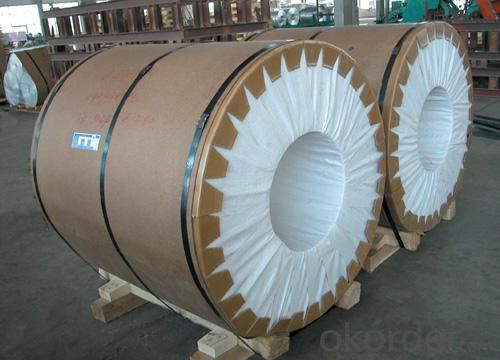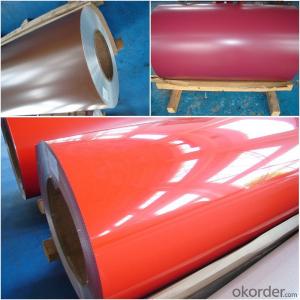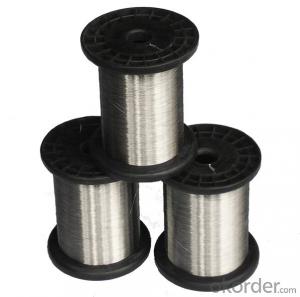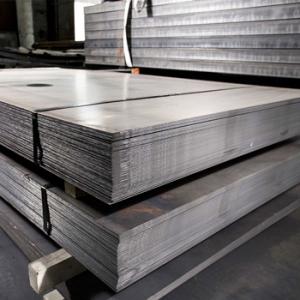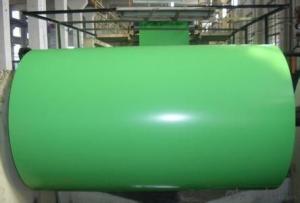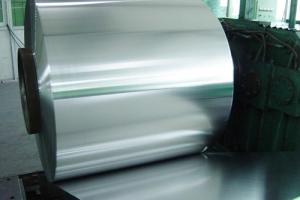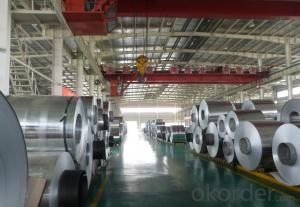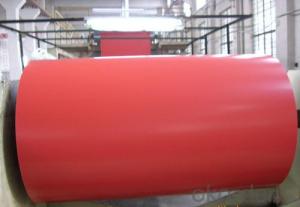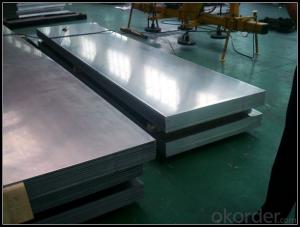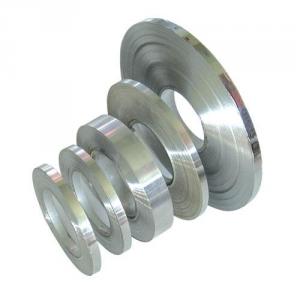Aluminum Sheets for Sale Ireland - Aluminum Coil for Aluminum Foil Stock
- Loading Port:
- Shanghai
- Payment Terms:
- TT or LC
- Min Order Qty:
- 5 m²
- Supply Capability:
- 9000 m²/month
OKorder Service Pledge
OKorder Financial Service
You Might Also Like
Specifications
Grade
| 1000 Series: 1050 1060 1070 1100 1200 1235 etc. 3000 Series: 3003 3004 3005 3104 3105 3A21 etc. 5000 Series: 5005 5052 5083 5086 5154 5182 5251 5754 etc. 6000 Series: 6061 6063 6082 6A02 etc. 8000 Series: 8006 8011 8079 etc. |
Thickness | 0.05~10mm |
Width | <1600mm |
Color | Metallic, Solid, RAL or by customer requirements |
Coating paint: | PVDF(Polyvinylidene Fluoride), PE(Polyester ) |
Coating thickness | as per customer’s request |
Gloss | 10-90%(EN ISO-2813:1994) |
Total coating thick | Polyester18~27micron(EN ISO-2360:1995) PVDF27 ~35micron(EN ISO-2360:1995) |
Coating hardness | 2H |
Protective film | PVC film, Colorless transparent or White-black |
Adhesion | 5B (EN ISO-2409:1994) |
Impact resistance | No cracking and peeling (A.S.T.M D2794-1993) |
Flexibility (T-bend) | 0T- 2T |
Temper | H16, H18, H24, H26, H26 |
Certification | ISO9001:2000, CE, SGS |
Coil's standard diameter | 1100mm |
Inner Diameter | 405mm/505mm |
Coil's standard weight | 2000kgs |
Payment | L/C ,T/T |
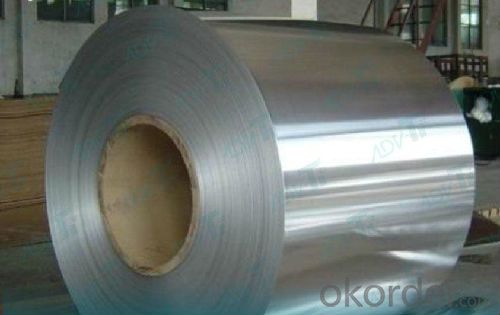
Parameter
| Product | Alloy | Temper | Thickness | Width | I.D(mm) | Application |
| Aluminum Coil/Strip | 1050,1060,1070, 1100,1200,1235, 1145,3003,304, 3105,3A21, 8011 | O H12 H14 H16 H18 H22 H24 H26 | 0.2-8mm | 50-2400mm | 75,150 200,300 400,505 (as customers's request) | construction,decoration, automobile,electronic, machinery,boat construction, aeronatics&astronautics, cookware,packing etc. |
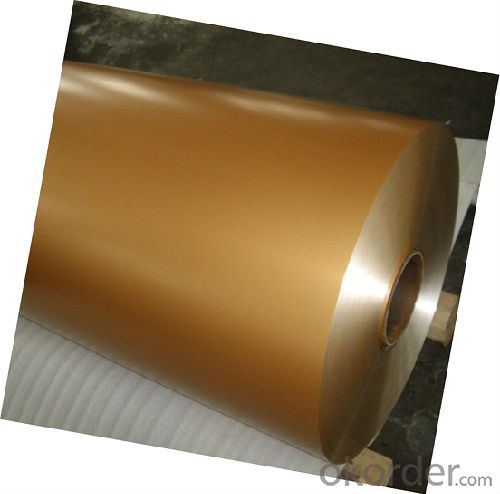
Application:
1) Radiator
2) Condenser
3) Insulation Material
4) Construction
5) Decoration
6) Advertisement and market applications
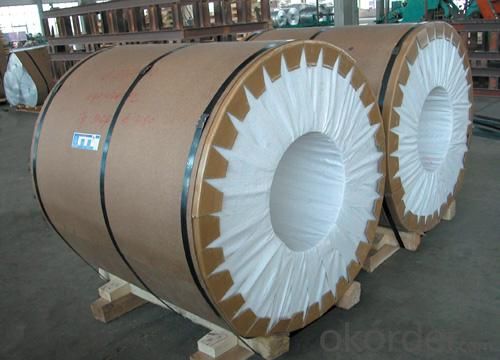
- Q: What is the surface finish of 101 aluminum sheets?
- The surface finish of 101 aluminum sheets can differ based on the specific manufacturing process and desired application. However, typical surface finishes for these sheets include mill finish, brushed finish, anodized finish, and painted finish. The mill finish refers to the untreated surface of the aluminum sheet, which may have some small imperfections or scratches. To achieve a brushed finish, the surface of the sheet is brushed with a fine abrasive material, resulting in a smooth and satin-like appearance. Anodized finish involves an electrochemical process that creates a protective oxide layer on the aluminum surface, giving it enhanced durability and resistance against corrosion. On the other hand, a painted finish involves applying a layer of paint onto the aluminum sheet to give it color and additional protection. Ultimately, the choice of surface finish for 101 aluminum sheets depends on the specific aesthetic, functional, and environmental requirements of the application.
- Q: This question asks about the distinctions between aluminum sheets that are produced domestically versus those that are imported.
- <p>Yes, there can be differences between domestic and imported aluminum sheets. These differences may include quality standards, material composition, thickness, surface finish, and price. Domestic sheets are often produced to meet local standards and regulations, while imported sheets may adhere to different international standards. The manufacturing process and raw materials used can also vary, leading to differences in durability, strength, and workability. Additionally, imported sheets might have different certifications or come from countries with lower production costs, which can affect the price. However, it's important to note that not all imported aluminum sheets are of lower quality; some may be of higher quality or have specific characteristics that are not available domestically.</p>
- Q: Can aluminum sheet be used for reflective surfaces?
- Indeed, reflective surfaces can be achieved with the use of aluminum sheet. Renowned for its exceptional reflectivity, aluminum is widely preferred for an array of applications that call for reflective surfaces. By skillfully polishing aluminum sheets, they can attain a remarkable luster, enabling them to reflect light and produce a mirror-like effect. Consequently, they prove to be the perfect choice for applications such as lighting fixture reflectors, solar panels, mirrors, and decorative purposes. Moreover, owing to its reflective properties, aluminum is an ideal material for situations necessitating heat reflection, including thermal insulation and roofing materials. In summary, aluminum sheets offer versatility and effectiveness when it comes to generating reflective surfaces.
- Q: The question asks if it is possible to recycle used aluminum foil to create new aluminum sheets.
- <p>Yes, recycled aluminum foil can be used to make new aluminum sheets. The process involves collecting and sorting the foil, which is then cleaned and melted down. The molten aluminum is poured into molds or rolled into sheets, creating new aluminum products. This recycling method is not only environmentally friendly but also economically viable as it saves energy compared to producing aluminum from raw materials.</p>
- Q: Are the aluminum sheets suitable for manufacturing solar reflectors?
- Aluminum sheets, indeed, prove to be fitting for the production of solar reflectors. As a material, aluminum possesses high reflectivity, enabling it to efficiently bounce off sunlight, thereby making it an optimal selection for solar reflectors. Its remarkable reflectivity and minimal heat absorption, owing to its low emissivity, allow it to effectively deflect a substantial amount of solar radiation. Moreover, aluminum exhibits qualities of being lightweight, long-lasting, and resistant to corrosion, rendering it appropriate for outdoor usage. Furthermore, its malleability permits simple shaping and molding into diverse reflector designs. All in all, aluminum sheets offer exceptional performance and dependability when it comes to constructing solar reflectors in solar energy systems.
- Q: Excuse me: what kind of aluminum sheet is the cheapest? Which materials are more expensive?
- Among them, 3003 for aluminum manganese alloy, the lowest price in the 3 series, and then 3004.3104, for aluminum, magnesium, manganese alloy than 3003 price to be slightly higherThird bit, 5 series, i.e. aluminum magnesium alloy, such as 5005.50525083. 5005 of these prices are slightly lowerThen, the ---2 system and --4 system and --7 system of the 6 series are derived
- Q: What are the different types of aluminum sheets?
- There are several different types of aluminum sheets available, each with its own unique characteristics and applications. Here are some of the most common types: 1. Plain aluminum sheet: This is the most basic type of aluminum sheet, characterized by its smooth surface and uniform thickness. It is widely used in various industries for general purposes. 2. Embossed aluminum sheet: This type of sheet has a textured or patterned surface, which is achieved by rolling the aluminum through a patterned roller. It is commonly used for decorative purposes, such as in interior design or automotive trim. 3. Perforated aluminum sheet: As the name suggests, this type of sheet contains small holes or perforations throughout its surface. It is often used in architectural applications, such as building facades or sunscreens, as well as in filtration systems. 4. Treadplate aluminum sheet: Also known as checker plate or diamond plate, this sheet has a raised pattern of lines or diamonds on its surface. This pattern provides added traction and makes it suitable for applications where slip resistance is important, such as industrial flooring or stair treads. 5. Anodized aluminum sheet: Anodizing is an electrochemical process that forms a protective oxide layer on the surface of the aluminum, making it more durable, corrosion-resistant, and able to accept dyes for color customization. Anodized aluminum sheets are commonly used in architectural applications, signage, and consumer products. 6. Painted aluminum sheet: This type of sheet is coated with a layer of paint, which not only enhances its appearance but also provides additional protection against corrosion. It is often used in applications where aesthetics are important, such as building facades, signage, or automotive parts. These are just a few examples of the different types of aluminum sheets available in the market. The choice of the right type depends on the specific requirements of the project, such as durability, appearance, corrosion resistance, or slip resistance.
- Q: Can aluminum sheets be used in construction?
- Construction can indeed utilize aluminum sheets. Aluminum, a versatile and lightweight material, possesses numerous advantageous properties for construction purposes. Its corrosion resistance allows for both indoor and outdoor applications. Moreover, aluminum sheets exhibit a high strength-to-weight ratio, granting them durability and strength while remaining relatively lightweight. This characteristic proves advantageous in construction projects where weight is a consideration. Furthermore, aluminum is non-toxic and highly recyclable, making it an environmentally conscious option. When combined with its aesthetic appeal and ease of fabrication, aluminum sheets become a favored choice for a variety of construction applications such as roofing, cladding, wall panels, window frames, and more.
- Q: What unique cleaning techniques should be employed when cleaning aluminum sheets?
- <p>Yes, there are special cleaning methods for aluminum sheets. It's important to use a gentle, non-abrasive cleaner to avoid scratching the surface. Avoid using harsh chemicals or abrasive materials that can damage the aluminum. Instead, use a soft cloth or sponge with a mild detergent solution. Rinse thoroughly with water to remove any cleaning residue, as some detergents can leave a film on the aluminum. Dry the aluminum sheet immediately after rinsing to prevent water spots. Regular cleaning can help maintain the appearance and longevity of aluminum sheets.</p>
- Q: What are the common thicknesses of aluminum sheets used in construction?
- The common thicknesses of aluminum sheets used in construction typically range from 0.032 inches (0.8 mm) to 0.125 inches (3.2 mm).
Send your message to us
Aluminum Sheets for Sale Ireland - Aluminum Coil for Aluminum Foil Stock
- Loading Port:
- Shanghai
- Payment Terms:
- TT or LC
- Min Order Qty:
- 5 m²
- Supply Capability:
- 9000 m²/month
OKorder Service Pledge
OKorder Financial Service
Similar products
Hot products
Hot Searches
Related keywords



